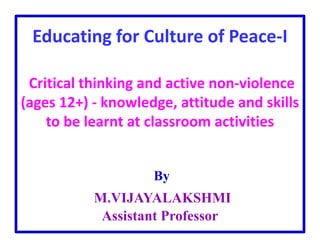
Educating for Culture of Peace-I
- 1. Educating for Culture of Peace-I Critical thinking and active non-violence (ages 12+) - knowledge, attitude and skills to be learnt at classroom activities By M.VIJAYALAKSHMI Assistant Professor
- 2. Objectives At the end of the course the student teacher will 1. Understand the concept of peace education. 2. Understand the dynamics of transformation of violence into Peace. 3. Understand the nature of conflicts and their resolution. 4. Imbibe the knowledge, attitudes and skills needed to achieve and sustain a global culture of peace. 5. Adopt peace education in the curriculum.
- 3. Unit – 6: Educating for Culture of Peace-I 6.1 Ecological Thinking and respect for life (ages 8-12) 6.2 Tolerance and respect for human rights (ages 11 to 16) 6.3 Critical thinking and active non-violence (ages 12+) - knowledge, attitude and skills to be learnt at classroom activities
- 4. Unit – 6: Educating for Culture of Peace-I 6.3 Critical thinking and active non- violence (ages 12+) - knowledge, attitude and skills to be learnt at classroom activities
- 5. • Peace Education began as a response to violence and war. As stated in the preamble of the Constitution of UNESCO (United Nations Educational, Scientific and Cultural Organization), “Since wars began in the minds of men, it is in the minds of men [and women] that the defenses of peace must be constructed.”
- 6. • Hence the knowledge, attitudes and skills to be imparted prevent violence and promote the nonviolent resolution for conflicts. • A culture of peace can be achieved through understanding the global issues and to be equipped with the conflict resolution skills to struggle for justice non-violently.
- 7. • Critical thinking is an essential skill to explore nonviolent responses to conflict. • Practicing critical thinking skills involves active listening, withholding judgment, questioning assumptions and stereotypes, exploring alternative interpretations of information and allowing time tor self- reflection and contemplation.
- 8. • In a conflict situation, these skills enable us to take a step back, rational assessment of the situation, and make responsible choices about how to act and react. • This activity may be most suited for youth over the age of twelve. • The following Critical Conversation exercise will enable students to practice active listening, critical thinking and nonviolent responses to conflict.
- 9. Learning Objectives At the end of the activity students will be able to achieve the following: Knowledge • Expose to a “win-win”, cooperative learning strategy • Gain experience with nonviolent approaches to conflict resolution • To understand the nature of conflict
- 10. Attitudes • Exhibit non-judgemental attitudes • Listen to and hear others’ views
- 11. Skills • Practice empathy and compassionate treatment of others • Practice active listening and reflection • Gain competence in identifying and challenging assumptions • Use cooperative problem-solving skills to achieve goals • Enhance abilities in imagining alternatives to violence raise pupils’ self-esteem
- 12. Learning Activity 1: Resolve Conflict Nonviolently • Conflict is a part of our life. Although we do not like conflicts, we have to face them in life. • Introduction about conflict; this activity can be used to discuss about the basic nature of conflict.
- 13. • Step 1: • Let’s find synonyms for conflict, e.g. quarrel, fight. • Teacher has to ask each student to write down on a piece of paper the immediate feelings, reactions, memory, or thoughts that come to his or her mind when they hear the word ‘conflict’ • Expected responses: anger, assault, violent behaviour, harsh words, etc.
- 14. • Step 2: • Teacher can ask them to write a definition of conflict and make them read it out to the class. • Putting together the best concepts, in their definitions, teacher has to find a comprehensive definition and should write it on the board. • Example: Conflict is a situation between two parties over a disagreement on an issue in which they have a common interest.
- 15. • Step 3: • Teacher can divide the class into five groups and give them five minutes to select a type of conflict and rehearse role-playing it. • Make each group presents their role-play to the class. Every presentation should be followed by a discussion with a view to understand the nature of the conflict.
- 16. • Step 4: • Discussion: • Finally, the teacher should bring the groups back together to resume the discussion by asking the following questions to the students. Then teacher should make a summary of the discussion on the board. • What did you learn about conflicts? • What are the basic types of conflicts? • Why do people have conflicts?
- 17. Learning Activity 2: Resolving Conflict Learning Activity 3: Controlling Anger
- 18. Sources are taken from •Slidesharenet.com •Web sources
